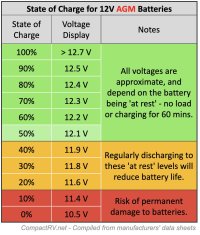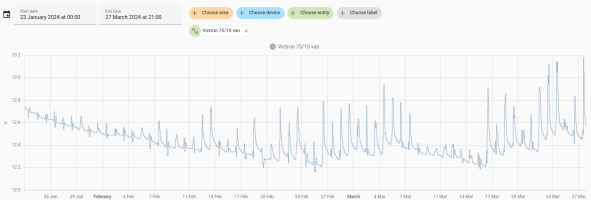PurpleLizC789
VIP Member
I can't decide whether our leisure battery drains more than usual. If the van sits on the drive for 2-3 weeks then the battery will drain down to 40-50%. I'm not sure if that's normal, maybe it is?
This weekend we went away in the hot weather, charged the battery up fully at home the day before we left as we were staying in a pub car park the first night (so no hook up). I put the fridge on a couple of hours before we left and then we drove 2 hours to our pub stop, so it should have been fully charged on arrival (I didn't think to use max charge function though, so I guess this is the equivalent of 80% even though it shows as 'full' on the diagram). We camped overnight and the only power draw would have been the fridge and a little bit of lighting (given that the evenings are light and we were in the pub, this wasn't much). The following day we only drove 20-30 minutes to park somewhere for a walk and then 20-30 minutes at the end of the day to a campsite with hook-up. On arrival at the campsite on day 2 we noticed that the battery was down to 50%. I couldn't quite believe that we used 50% of the battery to camp 1 night off hook-up! Last year we camped 4 nights in a row without hook-up in a hired van with only a few short drives to re-charge the battery.
Given that the only power draw is the fridge, I'm wondering if this is more of a problem in hot weather and also in a black van?! We've only had the van since November so this is the first time we've used it in warmer weather. As we were only away 2 nights the fridge wasn't very full, so I'm wondering if I need to try to fill the fridge up more in hot weather to make it easier for it to stay cool. I'm wondering what other people's experiences are?
This weekend we went away in the hot weather, charged the battery up fully at home the day before we left as we were staying in a pub car park the first night (so no hook up). I put the fridge on a couple of hours before we left and then we drove 2 hours to our pub stop, so it should have been fully charged on arrival (I didn't think to use max charge function though, so I guess this is the equivalent of 80% even though it shows as 'full' on the diagram). We camped overnight and the only power draw would have been the fridge and a little bit of lighting (given that the evenings are light and we were in the pub, this wasn't much). The following day we only drove 20-30 minutes to park somewhere for a walk and then 20-30 minutes at the end of the day to a campsite with hook-up. On arrival at the campsite on day 2 we noticed that the battery was down to 50%. I couldn't quite believe that we used 50% of the battery to camp 1 night off hook-up! Last year we camped 4 nights in a row without hook-up in a hired van with only a few short drives to re-charge the battery.
Given that the only power draw is the fridge, I'm wondering if this is more of a problem in hot weather and also in a black van?! We've only had the van since November so this is the first time we've used it in warmer weather. As we were only away 2 nights the fridge wasn't very full, so I'm wondering if I need to try to fill the fridge up more in hot weather to make it easier for it to stay cool. I'm wondering what other people's experiences are?
















